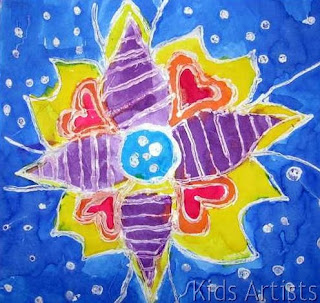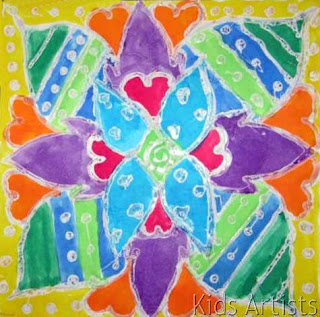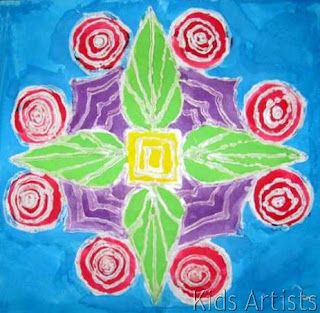.jpg)
.jpg)
You need:
- drawing paper A4 size
- markers
- black waterproof marker
- coloured paper for background
- glue
Joan Miró's (Spain, 1893-1983) work contains paintings, sculptures, textile works and theatre. His paintings contain many playful and colourful organic forms. in his work you'll see basic colours as blue, green, red, black and yellow. The bright coloured surfaces are bordered or crossed by black lines. The unrealistic shapes, bright colours and lines resemble the work of children. Recurring themes are heavenly bodies and ladders. Many of the images in his paintings have eyes. In this way the work looks for direct eye contact with the one who looks at it.
Show several works of Miro on the digital board. Discuss the striking things: bright colours, many eyes, forms are bordered or crossed with black lines, different lines, different forms.
Tell the students about the difference between geometric forms (forms of mathematics, such as square, circle, triangle, etc) and organic forms (natural forms, free forms) and draw examples of them on the digital board. Discuss different line types and draw them on the board too.
The task is: draw an animal or a human being with waterproof black marker. Don't sketch first, draw directly with the marker! Your figure should consist of organic and / or geometric shapes. Divide large fields in forms or make them smaller with different lines. Colour your drawing with bright colours. Decorate the background with lines, shapes and coloured eyes.
Paste the work finally on a coloured background.
.jpg)
.jpg)
All works are made by children of 10-11 years old
.jpg)
.jpg)
.jpg)
.jpg)



.jpg)
.jpg)
.jpg)
.jpg)
.jpg)
.jpg)
.jpg)
.jpg)
.jpg)
.jpg)
.jpg)
.jpg)



.jpg)
.jpg)
.jpg)
.jpg)



.jpg)
.jpg)
.jpg)
.jpg)

.jpg)
.jpg)
